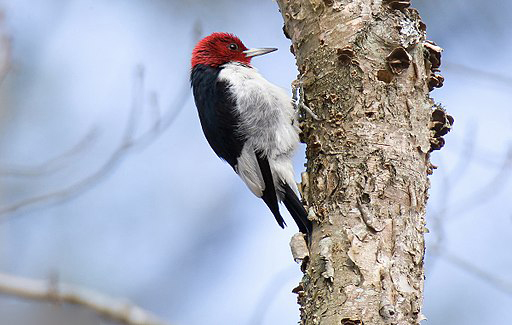Information About The Bird
Seen/Heard at
Decorah, Decorah North
Diet
Although the Red-headed Woodpecker eats nuts and seeds, Cornell lists it as a flycatcher. Red-headed Woodpeckers feed on insects such as beetles, cicadas, midges, honeybees, flies, and grasshoppers; other invertebrates, seeds, corn, berries and other fruits; and occasionally eggs, nestlings, mice, and adult birds. The area around the North nest offers exactly the habitat Red-headed Woodpeckers like: an open oak woodland with an abundance of cavities and plenty of acorns and hickory nuts to eat and stash, as this link shows: https://youtu.be/uonBSXW0yXw. They are one of only four woodpecker species that commonly cache or store food, and the only woodpecker known to cover stored food with pieces of wood or bark.
Nesting
Red-headed Woodpeckers breed from late May through early September. Male woodpeckers select a dead tree trunk, tree limb, or fence post, and begin excavating a hole. They attract females by calling, drumming, and tapping. While females help work on the nest site, the male does most of the excavation. Red-bellied Woodpeckers lay three to ten white eggs per clutch on a bed of wood chips and may produce up to two broods per year. Both sexes incubate eggs for 12-14 days and young stay in the nest for 24-31 days before fledging. The male incubates at night, the female incubates during the day, and both sexes provide parental care. To learn more, visit Cornell’s website.
Compared with tongues of other woodpeckers, Red-headed Woodpeckers have shorter, less extensible tongues. Instead of barbs, they have fine bristles. These bristles help collect sap and may be an adaptation to their more generalized diet.
Citations
Bird Range Maps of North America
Ridgely, R.S., T.F. Allnutt, T. Brooks, D.K. McNicol, D.W. Mehlman, B.E. Young, and J.R. Zook. 2003.
Digital Distribution Maps of the Birds of the Western Hemisphere, version 1.0. NatureServe, Arlington, Virginia, USA. Data provided by NatureServe in collaboration with Robert Ridgely, James Zook, The Nature Conservancy – Migratory Bird Program, Conservation International – CABS, World Wildlife Fund – US, and Environment Canada – WILDSPACE.
Web Link: http://bit.ly/2ynPQ5I
The Cornell Lab of Ornithology Birds of North America: https://birdsna.org/Species-Account/bna/species/rehwoo/introduction.
General Description
Adult Red-headed Woodpeckers have bright red heads, white underparts, black backs, and black wings with large white patches.
Migration
Red-headed Woodpeckers are year-round residents in the Decorah area, although some winter woodpeckers could be migrants from colder northern areas. In general, Red-headed Woodpeckers irrupt rather than migrate, moving around to find food during the winter months.
Measurements
Length: 7.5-9.1 in/19-23 cm
Wingspan: 16.5 in/42 cm
Weight: 2.0-3.2 oz/56-91 g
Wing Design
Relatively elliptical. Excellent at taking off quickly, maneuvering through branches, and avoiding predators.
